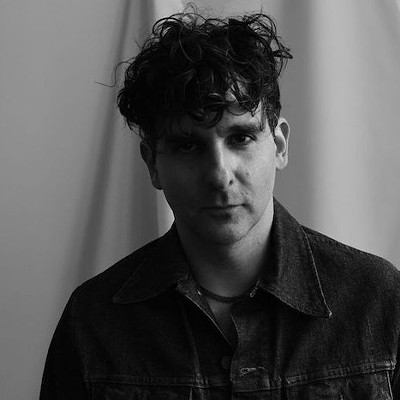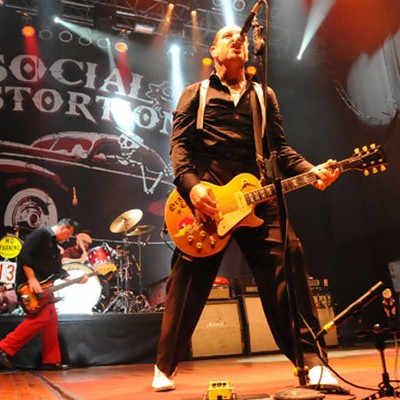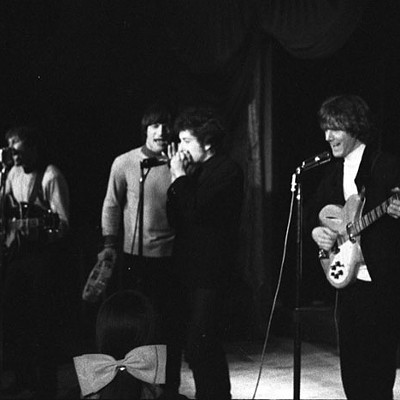Adam P. Newton recently became a father for the first time, so he has decided to explain the entirety of post-WWII Western pop music to his new daughter, “Fig”… one genre at a time.
What’s up, Fig? While folks from our last installment like Jimmie Rodgers and Hank Williams Sr. plied their trade in honky-tonks and dance halls across Texas and the South, the artists on this list were lighting up clubs, bars and dance floors with horns, strings and vibrant arrangements that displayed great musical creativity, a wry sense of humor and its own brand of romance. And it certainly didn’t hurt that jazz of the 1920s, ’30’s and ‘40s got people off their feet and into each other's arms with a series of inventive dance steps.
It’s also important to understand how collaborative this era was. Many of these artists performed with each other throughout their careers — some were pianists, and others were stellar singers, while some played trumpet, saxophone or guitar. And even more were composers and bandleaders who arranged tunes and created a cohesive sound. There are several mentor/protégé pairs on this list, while others were friends and long-term coworkers who simply “got” each other’s sensibilities.
However, I would be remiss not to mention the racial segregation that defined the times and affected the milieu in which these artists performed. There was very little mixing of audiences during the early jazz era, much like there was limited racial intermingling in America in general. We recognize now that big band, swing and jazz have a great deal in common musically — but in their heyday, they were often kept apart by the race and socioeconomic status of the fans and practitioners.
So, with that bit of cultural knowledge in our hands, let’s discuss the actual music that made those crowds jump, jive and wail.
LOUIS ARMSTRONG, “Heebie Jeebies”
A founder of jazz, “Satchmo” brought the genre out of Dixieland and ragtime (think Joe “King” Oliver and Scott Joplin) with his inventive combination of soaring cornet lines, scat singing and musical whimsy. His lighthearted tone set the stage for where jazz could go — especially in terms of crossing racial barriers. On this track, you hear a tight group of musicians each performing an intricate melodic phrase without ever stepping on each other’s toes, which allowed plenty of room for soloists and dancers to groove.
BESSIE SMITH, “Nobody Knows You When You’re Down and Out”
Good Lord, this woman’s voice is so wonderful. Often referred to as “Empress of the Blues,” Smith reigned supreme as a jazz vocalist for about ten years before her untimely death in 1937. While her lyrical content was similar to that of blues musicians of the era, her prodigious vocal abilities set her apart, preferring to back her powerful and raspy alto with 12-bar jazz passages and not warbling guitar licks. Do yourself a favor and never listen to the version of this track Eric Clapton released on his Unplugged record back in 1992. It lacks all the pain and heartbreak of Bessie’s.
DUKE ELLINGTON, “It Don’t Mean a Thing (If It Ain’t Got That Swing)”
A prodigious composer and talented pianist, Ellington helped push jazz out of clubs and into the wider pantheon of western American music with his penchant for three-minute tunes perfect for selling 78s and 45s. His writing style balanced multilayered nuance with verve and a flair for a the dramatic. And as you can hear on this track, the horns bleat with power and clarity, while his piano playing was percussive and powerful and served as the root upon which everything else pivoted.
COUNT BASIE, “One O’Clock Jump”
Do you hear the rollicking piano riff in that video? That was the genius of Count Basie. He grew up playing vaudeville and silent-movie sound tracks, so he knew how to carry the tenor and weight of the moment with just music, but he was also an accomplished performer who slid easily between formal training and playing by ear. Such ability helped him grow with the times, because when the first wave of jazz and big band slipped in popularity post-World War II, he even found a way to incorporate some bebop into his act. But for Basie, it was always about the beat.
CAB CALLOWAY, “Minnie the Moocher”
While most folks of your Dad’s generation were introduced to Calloway and this song in 1980’s The Blues Brothers, this cat was already a legend in jazz and blues circles because of his tenure running things at The Cotton Club, one of the top jazz clubs in the country. Calloway was an electrifying performer, singer and bandleader whose over-the-top stage antics set the table for pop and rock performers decades later.
BENNY GOODMAN, “Sing, Sing, Sing (With a Swing)”
On one of the most iconic tracks by one of the most influential musicians of all time, Goodman graces your ears with his powerful clarinet wails (yes, I said powerful), while leading his group into a raucous groove that compels you to get off your feet. This is swing music — no matter what some ska band might tell you later in life — and Benny Goodman knew how to mesh jazz flair with classical stylings into a rambunctious good time. The drums rumble, the horns bleat and the music shines through into the 21st century.
DJANGO REINHARDT, “Minor Swing”
This dude. That guitar. That percussive style. Reinhardt is the only non-American under consideration on this list, but he earns it as one of the most influential guitar players of all time. Playing without the use of the fourth and fifth fingers on his left hand, he had to invent an entire way of playing to overcome that obstacle, resulting in a style few have been able to mimic. And on this standout track from his repertoire, you’re graced with rhythmic and frenetic licks that are still quite danceable and can fit into both jazz and swing schools.
LOUIS PRIMA, “Jump, Jive, An’ Wail”
An initial word of caution — don’t go looking for a version of this song from something called the Brian Setzer Orchestra. Prima merged New Orleans ragtime syncopation with big-band horn riffs to great effect and stupendous professional results. He possessed a magnetic personality and a penchant for danceable hooks. And for the Disney fans in your life, make sure you tell ‘em how Prima voiced King Louie in The Jungle Book, singing the track “I Wanna Be Like You.”
BILLIE HOLIDAY, “Strange Fruit”
One of the more passionate voices in the history of modern music, Holiday remains an iconic presence and ever-present touchstone for anyone wanting to build a career as a jazz or R&B singer. While I thought about discussing the breezy, loping “Summertime” — with its delightful conversation between clarinet and trumpet — I felt “Strange Fruit” to be more poignant, as it speaks to hard, painful racial realities with an aching pathos that can’t be duplicated. The effect is strengthened by the minimalist arrangement: Sparse jazz chords and Holiday’s earnest alto are all you need.
MUDDY WATERS, “Rollin’ Stone”
On one hand, Waters doesn’t quite fit tonally with the rest of this list, but we should address the link he represents between jazz, blues and what’s coming next in the progression of Western music. Much like Armstrong did for jazz, Waters brought the blues out of the Deep South and introduced it to wider audiences (especially the folks behind the coming British Invasion). When one of the most influential bands in an entire genre named itself after one of your songs, we need to discuss the impact of your music, from the electrified guitar licks and strong melodic core to the powerful and gritty rhythms.
ELLA FITZGERALD, “Oh, Lady Be Good”
The clarity of her voice and versatility of style served as Fitzgerald’s dual calling cards throughout her illustrious career. She began as a straight-up jazz singer in the ‘30s, but easily stretched her vocal legs into bebop and R&B as the 20th century progressed. While she frequently collaborated with folks like Jimmy Webb, Dizzy Gillespie and Louis Armstrong, her strong personal style always shone through, especially the scat singing virtuosity displayed with this selection.
NAT "KING" COLE, “(Get Your Kicks on) Route 66”
While Cole’s roots are firmly in the jazz and big-band camps, he eventually became quite the mainstream success. Led by his lively and textured piano playing, his songs possessed a keen pop sensibility before the concept really existed. Just listen to the groove and swing of “Route 66”: They feature catchy chord arrangements, familiar verse-chorus structure and enough jazz inflection to please serious and casual fans of the genre. So, while there’s nothing wrong with the most recognized song from Cole’s canon — “Unforgettable" — I’ve always preferred his upbeat tunes.
SARAH VAUGHAN, “Whatever Lola Wants”
Much like the aforementioned Cole and Waters, Vaughan serves as a great bridge to where music was heading by the late ‘40s and early ‘50s. She came of age with bebop instead of big band or swing, performing with artists like Dizzy Gillespie and Charlie Parker. With this selection, you hear her sultry yet saucy alto dance playfully with the percussion, plucked jazz guitar and a brash horn section, as she helped develop what R&B singing eventually became in the ‘60s.
Support Us
Houston's independent source of
local news and culture
account
- Welcome,
Insider - Login
- My Account
- My Newsletters
- Contribute
- Contact Us
- Sign out
[
{
"name": "Related Stories / Support Us Combo",
"component": "11591218",
"insertPoint": "4",
"requiredCountToDisplay": "4"
},{
"name": "Air - Billboard - Inline Content",
"component": "11591214",
"insertPoint": "2/3",
"requiredCountToDisplay": "7"
},{
"name": "R1 - Beta - Mobile Only",
"component": "12287027",
"insertPoint": "8",
"requiredCountToDisplay": "8"
},{
"name": "Air - MediumRectangle - Inline Content - Mobile Display Size 2",
"component": "11591215",
"insertPoint": "12",
"requiredCountToDisplay": "12"
},{
"name": "Air - MediumRectangle - Inline Content - Mobile Display Size 2",
"component": "11591215",
"insertPoint": "4th",
"startingPoint": "16",
"requiredCountToDisplay": "12"
}
,{
"name": "RevContent - In Article",
"component": "12527128",
"insertPoint": "3/5",
"requiredCountToDisplay": "5"
}
]
KEEP THE HOUSTON PRESS FREE...
Since we started the Houston Press, it has been defined as the free, independent voice of Houston, and we'd like to keep it that way. With local media under siege, it's more important than ever for us to rally support behind funding our local journalism. You can help by participating in our "I Support" program, allowing us to keep offering readers access to our incisive coverage of local news, food and culture with no paywalls.
Adam P. Newton
Contact:
Adam P. Newton
Trending Music
- How Much Longer Can Classic Rock Rule the Roost?
- Wang Chung Headline a Musical Time Trip to the '80s...and Land on the Moon!
- Top 10 Butt-Rock Bands of All Time
-
Sponsored Content From: [%sponsoredBy%]
[%title%]

Don't Miss Out
SIGN UP for the latest
Music
news, free stuff and more!
Become a member to support the independent voice of Houston
and help keep the future of the Houston Press FREE
Use of this website constitutes acceptance of our
terms of use,
our cookies policy, and our
privacy policy
The Houston Press may earn a portion of sales from products & services purchased through links on our site from our
affiliate partners.
©2024
Houston Press, LP. All rights reserved.




